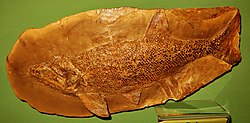| Taxon | Species | Presence | Notes | Images |
|---|
| Agnosphitys [2] [3] | A. cromhallensis [2] [3] | Geographically present in Avon, England (now Bristol). [2] | Its remains include a left ilium (holotype) and a left maxilla, astragalus and humerus (referred specimen). [2] |  |
| Agrosaurus [4] [2] | A. macgillivrayi [4] [2] | Geographically present in Avon, England (now Bristol). Originally believed to have been found in Cape York Peninsula, Queensland (Australia). [2] | A tibia, a claw and some other fragments. [2] | |
| Asylosaurus [2] [5] | A. yalensis [2] [5] | Geographically present in Avon, England (now Bristol). [2] [6] | Dorsal vertebrae, ribs, gastralia, a shoulder girdle, humeri, a partial forearm, and a hand; additional bones from the neck, tail, pelvis, arm and legs that may represent the same individual. [5] [2] |  |
| Chimaeriformes [7] | Indeterminate [7] | Geographically present in Bristol. [2] | Indeterminate remains. [7] | |
| Clevosaurus [8] | C. hudsoni [8] | Geographically present in Gloucestershire. [2] | Partial cranial and post-cranial skeleton (holotype). [8] |  |
| Crinoidea [7] | Indeterminate [7] | Geographically present in Bristol. [2] | Reworked from older Carboniferous sediments (Friars Point Limestone Formation). [9] | |
| Diphydontosaurus [7] | D. avonensis [7] | Geographically present in Bristol. [2] | Complete to near-complete specimens. [7] |  |
| Hybodontiformes? [10] | Indeterminate [10] | Geographically present in Bristol. [2] | Indeterminate remains. [10] | |
| Gyrolepis [11] | Indeterminate [11] | Geographically present in Bristol. [2] | Indeterminate remains. [11] |  |
| Lissodus [10] | L. minimus [10] | Geographically present in Bristol. [2] | Teeth. [10] |  |
| Palaeosaurus [2] [5] | P. cylindrodon [2] [5] | Geographically present in Avon, England (now Bristol) and Bristol. [2] | Two teeth (one destroyed in 1940). [2] |  |
| Planocephalosaurus [12] [13] | P. robinsonae [12] [13] | Geographically present in Bristol. [2] | Skull (holotype). [12] | |
| Rhomphaiodon [10] | R. minor [10] | Geographically present in Bristol. [2] | Teeth. [10] | |
| Rileyasuchus [2] [14] [15] | R. bristolensis [2] [14] [15] | Geographically present in Bristol. [2] | Two vertebrae and a humerus. [2] | |
| Terrestrisuchus ? [10] [7] | Indeterminate [10] [7] | Geographically present in Bristol and South Wales. [2] | Indeterminate remains. [10] [7] |  |
| Theropoda [2] | Indeterminate [2] | Geographically present in Avon, England (now Bristol) and Bristol. [2] | Indeterminate remains. [2] Possibly similar to Pendraig milnerae . [16] | |
| Thecodontosaurus [2] | T. antiquus [2] | Geographically present in Avon, England (now Bristol) and Bristol. [2] | Partial cranial and postcranial remains (holotype is a lower jaw). [2] |  |









